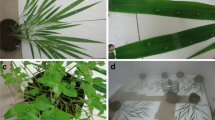Abstract
Colletotrichum nymphaeae, causal agent of celery stunt anthracnose, has caused severe damage to celery production in Nagano Prefecture, Japan. For elucidating the infection cycle, celery seeds in the prefecture were screened on a selective medium and found to harbor C. nymphaeae as did seeds harvested from plants with diseased leaves. When seed samples with 1 and 10 % of the seeds infested were sown and grown, stunt anthracnose developed on seedlings, then finally spread extensively to other plants, suggesting that primary transmission occurred from seeds to seedlings, followed by secondary infection to other plants. These results strongly suggest that the disease cycle of the celery stunt anthracnose is completed through seed transmission in Nagano Prefecture. To disrupt the infection cycle, seed sterilization with hot water was tested. Conidia of C. nymphaeae in suspensions were killed by treatment at 50 °C for 40 min or at >55 °C for 10 min. Seedlings grown from seeds treated at 50 °C for 30 min did not develop any symptoms, and germination was not affected. Thus, hot water treatment at 50 °C for 30 min was the best method to eradicate the stunt anthracnose of celery.


Similar content being viewed by others
References
Bob D, Persley D (2010) Celery. In: Persley D et al (eds) Diseases of vegetable crops in Australia. CSIRO Publishing, Australia, pp 107–112
Chikuo Y, Sugimoto T (1984) Infection of sugar beet seed by Colletotrichum dematium f. spinaciae (in Japanese with English summary). Ann Phytopath Soc Japan 50:249–254
Damm U, Cannon PF, Woudenberg JHC, Crous PW (2012) The Colletotrichum acutatum species complex. Stud Mycol 73:3–113
Doornik AW (1992) Heat treatment to control Colletotrichun acutatum on corms of Anemone coronaria. Neth J Pl Path 98:377–386
Fujinaga M, Yamagishi N, Ogiso H, Takeuchi J, Moriwaki J, Sato T (2011) First report of celery stunt anthracnose caused by Colletotrichum simmondsii in Japan. J Gen Plant Pathol 77:243–247
Heaton JB, Dullahide SR (1993) Control of celery leaf curl disease caused by Colletotrichum acutatum. Australas Plant Path 22:152–155
Kuniyasu K (1999) Characteristics of the seed epidemic. In: Ohata K et al (eds) Ecology and control of seed borne disease (in Japanese). Japan Plant Protection Association, Tokyo, p 25
Nagai Y, Takeuchi T (1975) The dry heat seed disinfection method for the seed-borne disease damage of several sort vegetables. Ann Phytopath Soc Japan 41:269
Nakamura H, Kobayashi K, Yamada H (1981) Heat resistance of seeds in various vegetable crops (in Japanese with English summary). Bull Veg Ornam Crops Res Stn Japan Ser A 8:33–51
Sato T, Moriwaki J (2013) Molecular re-identification of strains in NIAS Genebank belonging to phylogenetic group A2 and A4 of the Colletotrichum acutatum species complex. Microbiol Cult Coll 29:13–23
Shivas RG, Tan YP (2009) A taxonomic re-assessment of Colletotrichum acutatum, introducing C. fioriniae comb. et stat. nov. and C. simmondsii sp. nov. Fungal Divers 39:111–122
Uematsu S, Mochizuki D, Tanaka C, Sato T (2009) A new selective medium for Colletotrichum gloeosporioides and C. acutatum (abstract in Japanese). Jpn J Phytopathol 75:187–188
Webster SK (1921) Treatment of celery seed for the control of Septoria blight. J Agric Res 21:369–372
Acknowledgments
Special thanks to Mr. Munetoshi Aoki, Nagano Vegetable and Ornamental Crops Experiment Station, for careful technical assistance.
Author information
Authors and Affiliations
Corresponding author
Rights and permissions
About this article
Cite this article
Yamagishi, N., Fujinaga, M., Ishiyama, Y. et al. Life cycle and control of Colletotrichum nymphaeae, the causal agent of celery stunt anthracnose. J Gen Plant Pathol 81, 279–286 (2015). https://doi.org/10.1007/s10327-015-0598-7
Received:
Accepted:
Published:
Issue Date:
DOI: https://doi.org/10.1007/s10327-015-0598-7




